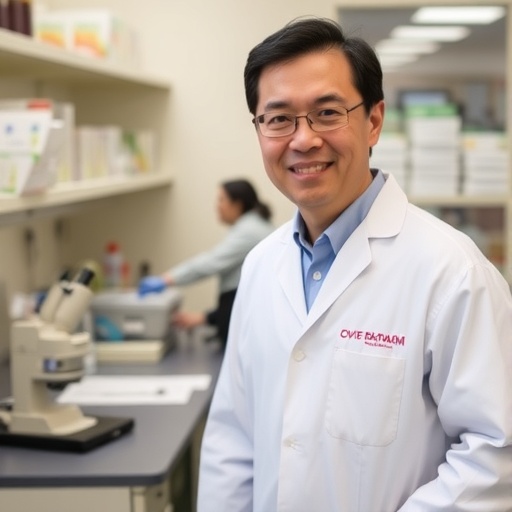Pancreatic ductal adenocarcinoma (PDAC) remains one of the most formidable challenges in oncology today, with a dismal five-year survival rate lingering below 10%, underscoring an urgent need for breakthrough therapeutic strategies. Researchers at the University of Cincinnati Cancer Center have embarked on a pioneering investigation into the intricate tumor microenvironment of PDAC, revealing a critical protein that exacerbates treatment resistance and developing a novel drug candidate that offers new hope for combating this lethal cancer. Their findings signify a substantial advance in understanding and potentially overcoming the formidable barriers that have long hindered effective treatment.
PDAC’s tumor microenvironment is a highly complex ecosystem composed not only of malignant cells but also encompassing immune cells, vasculature, and stromal tissues. This dynamic and often hostile milieu orchestrates immune evasion, limiting the efficacy of immune-mediated tumor suppression. Traditional therapeutic modalities, including chemotherapy and radiotherapy, often fail to penetrate or effectively disrupt this microenvironment, resulting in poor clinical outcomes. The University of Cincinnati team focused their research on deciphering the molecular mechanisms underpinning this immunosuppressive landscape, with the aim of identifying new molecular targets for therapy.
At the center of their discovery is the heat shock protein 70 (Hsp70), a molecular chaperone long recognized for its essential role in maintaining cellular homeostasis under stress conditions. While Hsp70’s ubiquitous function in protein folding and protection from cellular stress is well established, its specific involvement in facilitating immune suppression within the PDAC tumor microenvironment was previously underappreciated. The research unveiled that Hsp70 plays a pivotal role in modulating immune responses, effectively impairing the recruitment and activation of cytotoxic immune cells in the vicinity of cancerous tissues.
Building on this insight, the research team engineered a novel therapeutic agent named SapC-DOPG. This drug leverages the unique biochemical signature of PDAC cells, selectively targeting phosphatidylserine—a phospholipid abnormally exposed on the surface of tumor cells. SapC-DOPG’s design borrows from a predecessor compound, SapC-DOPS, developed by Dr. Xiaoyang Qi, which is advancing through clinical trials for lung cancer treatment. However, SapC-DOPG distinguishes itself by its specificity to Hsp70 within pancreatic cancer cells, offering a targeted mechanism to disrupt tumor survival pathways and potentially reverse immune suppression.
Animal model testing of SapC-DOPG yielded promising results, demonstrating not only a good safety profile but also significant reductions in tumor size and prolonged survival rates. These preclinical outcomes suggest that SapC-DOPG could overcome some of the intrinsic resistance mechanisms that have rendered PDAC so refractory to existing treatments. The drug’s ability to specifically engage and neutralize Hsp70 function within the tumor microenvironment represents a significant leap forward in PDAC therapeutic research.
The implications of this research extend beyond merely shrinking tumors; by alleviating immunosuppression, SapC-DOPG may restore the immune system’s capacity to recognize and eliminate cancer cells more effectively. This dual action of direct tumor targeting and immune modulation represents a paradigm shift in treating notoriously resistant cancers such as PDAC. It raises the possibility of combining SapC-DOPG with other immunotherapeutic strategies, potentially transforming the clinical management of pancreatic cancer.
Dr. Ahmet Kaynak, a postdoctoral fellow and trainee associate member of the Cancer Center, spearheaded this groundbreaking project. He stresses the importance of comprehending the tumor microenvironment’s complexity to identify novel targets that conventional therapies have overlooked. “Understanding how Hsp70 fosters an immunosuppressive niche highlights a new vulnerability in pancreatic tumors,” Kaynak explained. Such insight is crucial in driving the development of therapies capable of dismantling the tumor’s defenses.
The research journey also illustrates the vital role of mentorship and institutional support, with Dr. Kaynak acknowledging the guidance of his mentor, Dr. Xiaoyang Qi. Their collaborative synergy has propelled the conceptual framework and translational progress from the lab bench toward clinical applicability. Moreover, the findings have garnered recognition within the scientific community, with one of the team’s manuscripts receiving accolades as the Trainee Associate Membership Paper of the Year within the Cancer Center.
Looking forward, the team aims to translate their preclinical successes into clinical trials, assessing SapC-DOPG’s safety and efficacy in pancreatic cancer patients. The existing clinical data on SapC-DOPS provides a reassuring safety precedent, bolstering hopes that this novel analog will similarly exhibit a favorable therapeutic index. If successful, SapC-DOPG could become an invaluable addition to the limited arsenal against PDAC, offering improved responses and potentially extending patient survival.
The profound challenges imposed by PDAC’s unique microenvironment demand innovative approaches grounded in molecular precision. This research embodies such innovation, combining deep mechanistic understanding with pharmaceutical ingenuity. Funded by the Pancreatic Cancer Action Network, and supported by travel grants facilitating dissemination at key academic forums, this project epitomizes the dynamic and collaborative nature of modern cancer research.
As presentations at prestigious venues such as the American Association for Cancer Research’s Special Conference in Pancreatic Cancer and the Frontiers in Cancer Immunotherapy Conference attest, these findings are reshaping conversations within the oncology community. They not only deepen scientific knowledge but also herald a new era of targeted therapies designed to outmaneuver the sophisticated defense mechanisms wielded by PDAC.
In conclusion, the discovery of Hsp70’s role in promoting immunosuppression and the development of SapC-DOPG mark a watershed moment in pancreatic cancer research. This work not only elucidates a previously underrecognized biological mechanism but also translates this knowledge into a tangible therapeutic advance with clear clinical promise. As the fight against pancreatic cancer continues, innovations like these pave the way toward more effective, durable treatments that can ultimately improve patient outcomes.
Subject of Research: Pancreatic ductal adenocarcinoma tumor microenvironment and therapeutic resistance mechanisms.
Article Title: Not specified in the source content.
News Publication Date: Not explicitly stated; research publications planned for January and April 2025; conference presentation scheduled for September 2025.
Web References:
- https://pubmed.ncbi.nlm.nih.gov/39941817/
- https://www.mdpi.com/2072-6694/17/7/1224
- https://www.uc.edu/news/articles/legacy/healthnews/2015/02/lung-cancer-may-be-treatable-with-use-of-sapc-dops-technology.html
References: Available in the linked journal articles.
Image Credits: None provided.
Keywords: Pancreatic cancer, PDAC, tumor microenvironment, Hsp70, immunosuppression, SapC-DOPG, molecular chaperones, cancer immunotherapy, chemotherapy resistance, targeted therapy, novel drug development, preclinical cancer research.




